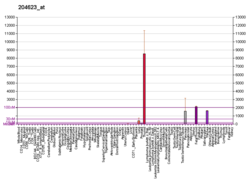TFF3
| TFF3 | |||||||||||||||||||||||||
|---|---|---|---|---|---|---|---|---|---|---|---|---|---|---|---|---|---|---|---|---|---|---|---|---|---|
 | |||||||||||||||||||||||||
| |||||||||||||||||||||||||
| 識別子 | |||||||||||||||||||||||||
| 記号 | TFF3, ITF, P1B, TFI, trefoil factor 3 | ||||||||||||||||||||||||
| 外部ID | OMIM: 600633 MGI: 104638 HomoloGene: 2427 GeneCards: TFF3 | ||||||||||||||||||||||||
| |||||||||||||||||||||||||
| |||||||||||||||||||||||||
| |||||||||||||||||||||||||
| |||||||||||||||||||||||||
| オルソログ | |||||||||||||||||||||||||
| 種 | ヒト | マウス | |||||||||||||||||||||||
| Entrez | |||||||||||||||||||||||||
| Ensembl | |||||||||||||||||||||||||
| UniProt | |||||||||||||||||||||||||
| RefSeq (mRNA) | |||||||||||||||||||||||||
| RefSeq (タンパク質) | |||||||||||||||||||||||||
| 場所 (UCSC) | Chr 21: 42.31 – 42.32 Mb | Chr 21: 31.34 – 31.35 Mb | |||||||||||||||||||||||
| PubMed検索 | [3] | [4] | |||||||||||||||||||||||
| ウィキデータ | |||||||||||||||||||||||||
| |||||||||||||||||||||||||
TFF3またはトレフォイル因子3(英: trefoil factor 3)は、ヒトではTFF3遺伝子によってコードされるタンパク質である[5][6][7]。
機能
[編集]トレフォイルファミリーのメンバーは、少なくとも1つのトレフォイルモチーフを持つことで特徴づけられる。トレフォイルモチーフは約40アミノ酸からなり、3つの保存されたジスルフィド結合が存在する。トレフォイルファミリーは胃腸粘膜で発現する安定な分泌タンパク質である。機能は多様であり、粘膜の保護、粘液の増粘、上皮の治癒の促進などがある。TFF3遺伝子は小腸や結腸の杯細胞などさまざまな組織で発現している。TFF3遺伝子と他の2つのトレフォイルファミリーのメンバーの遺伝子は21番染色体にクラスターとして存在する[7]。
糖鎖への結合
[編集]ヒトの3つのトレフォイル因子(TFF)はすべてレクチンであり、GlcNAc-α-1,4-Galの二糖に対して特異的に相互作用する[8]。この二糖は、粘膜の高度にグルコシル化されたムチンにのみ存在することが知られている糖鎖エピトープ(glycotope)である。TFFは2つの糖鎖エピトープに結合してムチンを架橋し、粘液の厚さと粘度を可逆的に調節する[8]。
母乳
[編集]TFFは、TFF1(gastric peptide)、TFF2(spasmolytic peptide)、そしてTFF3(intestinal trefoil factor)からなる。TFFはムチン産生細胞から分泌され、口腔粘膜表面の完全性の維持とrestitutionと呼ばれる過程による胃腸粘膜の治癒の増強に重要な役割を果たしている。また、ヒトの母乳にもかなりの量のTFFが存在する。乳から単離されたTFF3とヒト腸管上皮細胞におけるIL-6およびIL-8のダウンレギュレーションとの強い相関関係の証拠が示されている。一方、TFF3は培養上皮細胞を活性化してβ-ディフェンシン2(hBD2)とβ-ディフェンシン4(hBD4)の産生を引き起こす。これらの結果から、TFFは腸管上皮細胞を活性化し、ディフェンシンなどの自然免疫に関連するペプチドの産生を誘導することで、授乳中の乳児の免疫系に積極的に関与している可能性が示唆された[9]。
PAR2受容体の活性化
[編集]PAR2の活性化には2つの主要な機構が記載されている。1つは、プロテアーゼによるPAR2のN末端の細胞外領域の特異的切断によって受容体活性化ペプチドを露出させ、露出したテザードリガンドと受容体本体との相互作用によって細胞シグナル伝達を引き起こすものである。もう1つは、SLIGKVなど、受容体に結合する合成ペプチドによって、プロテアーゼによる作用を模倣するものである[10]。授乳期間中、ヒトの乳に分泌されたTFF3はPAR2受容体を介して腸管上皮細胞を活性化することで、hBD2やhBD4の発現やサイトカインの調節を誘導している可能性がある[10]。
臨床的意義
[編集]バレット食道の検出やスクリーニングの精度と許容性を向上させるため、摂取可能な食道サンプリングデバイス(Cytosponge)とTFF3を円柱上皮のマーカーとして利用した免疫細胞染色を組み合わせたプロセスが開発されている[11]。しかし、こうした検査の臨床的有用性は、胃の噴門部でTFF3が頻繁に染色されることや、それに伴う偽陽性のリスクという限界が存在する可能性がある[12]。
出典
[編集]- ^ a b c GRCh38: Ensembl release 89: ENSG00000160180 - Ensembl, May 2017
- ^ a b c GRCm38: Ensembl release 89: ENSMUSG00000024029 - Ensembl, May 2017
- ^ Human PubMed Reference:
- ^ Mouse PubMed Reference:
- ^ “Characterization of human and rat intestinal trefoil factor produced in yeast”. Biochemistry 34 (14): 4757–64. (May 1995). doi:10.1021/bi00014a033. PMID 7718582.
- ^ “Human trefoil peptides: genomic structure in 21q22.3 and coordinated expression”. Eur J Hum Genet 4 (6): 308–15. (May 1997). doi:10.1159/000472224. PMID 9043862.
- ^ a b “Entrez Gene: TFF3 trefoil factor 3 (intestinal)”. 2021年5月2日閲覧。
- ^ a b “Trefoil factors share a lectin activity that defines their role in mucus”. Nature Communications 11 (1): 2265. (May 2020). Bibcode: 2020NatCo..11.2265J. doi:10.1038/s41467-020-16223-7. PMC 7221086. PMID 32404934.
- ^ “Trefoil factor 3 isolated from human breast milk downregulates cytokines (IL8 and IL6) and promotes human beta defensin (hBD2 and hBD4) expression in intestinal epithelial cells HT-29”. Bosn J Basic Med Sci 12 (4): 256–64. (November 2012). doi:10.17305/bjbms.2012.2448. PMC 4362502. PMID 23198942.
- ^ a b “Trefoil factor 3 (TFF3) from human breast milk activates PAR-2 receptors, of the intestinal epithelial cells HT-29, regulating cytokines and defensins”. Bratislavské LekáRske Listy 117 (6): 332–9. (2016). doi:10.4149/bll_2016_066. PMID 27546365.
- ^ “Acceptability and accuracy of a non-endoscopic screening test for Barrett's oesophagus in primary care: cohort study”. BMJ 341: c4372. (2010). doi:10.1136/bmj.c4372. PMC 2938899. PMID 20833740.
- ^ “TFF3 expression at the esophagogastric junction is increased in gastro-esophageal reflux disease (GERD)”. Peptides 25 (5): 771–7. (2004). doi:10.1016/j.peptides.2004.01.018. PMID 15177871.
関連文献
[編集]- “Trefoil factor 3 isolated from human breast milk downregulates cytokines (IL8 and IL6) and promotes human beta defensin (hBD2 and hBD4) expression in intestinal epithelial cells HT-29”. Bosn J Basic Med Sci 12 (4): 256–64. (2012). doi:10.17305/bjbms.2012.2448. PMC 4362502. PMID 23198942.
- “Molecular medicine of TFF-peptides: from gut to brain”. Histol. Histopathol. 16 (1): 319–34. (2001). PMID 11193208.
- “Cell type specific expression of secretory TFF peptides: colocalization with mucins and synthesis in the brain”. Int. Rev. Cytol.. International Review of Cytology 213: 147–81. (2002). doi:10.1016/S0074-7696(02)13014-2. ISBN 978-0-12-364617-0. PMID 11837892.
- Langer G; Jagla W; Behrens-Baumann W et al. (2003). “Ocular TFF-peptides: new mucus-associated secretory products of conjunctival goblet cells”. Adv. Exp. Med. Biol. 506 (Pt A): 313–6. doi:10.1007/978-1-4615-0717-8_44. PMID 12613926.
- “Characterization of the genomic structure and the promoter region of the human intestinal trefoil factor”. Biochem. Biophys. Res. Commun. 214 (1): 195–9. (1995). doi:10.1006/bbrc.1995.2274. PMID 7669039.
- “Colitis-associated variant of TLR2 causes impaired mucosal repair because of TFF3 deficiency”. Gastroenterology 137 (1): 209–20. (2009). doi:10.1053/j.gastro.2009.03.007. PMC 2812790. PMID 19303021.
- Hauser F; Poulsom R; Chinery R et al. (1993). “hP1.B, a human P-domain peptide homologous with rat intestinal trefoil factor, is expressed also in the ulcer-associated cell lineage and the uterus”. Proc. Natl. Acad. Sci. U.S.A. 90 (15): 6961–5. Bibcode: 1993PNAS...90.6961H. doi:10.1073/pnas.90.15.6961. PMC 47055. PMID 8346203.
- Podolsky DK; Lynch-Devaney K; Stow JL et al. (1993). “Identification of human intestinal trefoil factor. Goblet cell-specific expression of a peptide targeted for apical secretion”. J. Biol. Chem. 268 (9): 6694–702. PMID 8454642.
- Schmitt H; Wundrack I; Beck S et al. (1996). “A third P-domain peptide gene (TFF3), human intestinal trefoil factor, maps to 21q22.3”. Cytogenet. Cell Genet. 72 (4): 299–302. doi:10.1159/000134208. PMID 8641134.
- “The gene encoding human intestinal trefoil factor (TFF3) is located on chromosome 21q22.3 clustered with other members of the trefoil peptide family”. Genomics 32 (2): 281–4. (1997). doi:10.1006/geno.1996.0117. PMID 8833157.
- Probst JC; Zetzsche T; Weber M et al. (1997). “Human intestinal trefoil factor is expressed in human hypothalamus and pituitary: evidence for a novel neuropeptide”. FASEB J. 10 (13): 1518–23. doi:10.1096/fasebj.10.13.8940297. PMID 8940297.
- Seib T; Blin N; Hilgert K et al. (1997). “The three human trefoil genes TFF1, TFF2, and TFF3 are located within a region of 55 kb on chromosome 21q22.3”. Genomics 40 (1): 200–2. doi:10.1006/geno.1996.4511. PMID 9070946.
- Tan XD; Liu QP; Hsueh W et al. (1999). “Intestinal trefoil factor binds to intestinal epithelial cells and induces nitric oxide production: priming and enhancing effects of mucin”. Biochem. J. 338 (3): 745–51. doi:10.1042/0264-6021:3380745. PMC 1220112. PMID 10051448.
- Hattori M; Fujiyama A; Taylor TD et al. (2000). “The DNA sequence of human chromosome 21”. Nature 405 (6784): 311–9. Bibcode: 2000Natur.405..311H. doi:10.1038/35012518. PMID 10830953.
- Berry A; Scott HS; Kudoh J et al. (2001). “Refined localization of autosomal recessive nonsyndromic deafness DFNB10 locus using 34 novel microsatellite markers, genomic structure, and exclusion of six known genes in the region”. Genomics 68 (1): 22–9. doi:10.1006/geno.2000.6253. PMID 10950923.
- Wiede A; Hinz M; Canzler E et al. (2001). “Synthesis and localization of the mucin-associated TFF-peptides in the human uterus”. Cell Tissue Res. 303 (1): 109–15. doi:10.1007/s004410000297. PMID 11235998.
- Yamachika T; Werther JL; Bodian C et al. (2002). “Intestinal trefoil factor: a marker of poor prognosis in gastric carcinoma”. Clin. Cancer Res. 8 (5): 1092–9. PMID 12006524.
- Kimura Y; Leung PS; Kenny TP et al. (2002). “Differential expression of intestinal trefoil factor in biliary epithelial cells of primary biliary cirrhosis”. Hepatology 36 (5): 1227–35. doi:10.1053/jhep.2002.36157. PMID 12395334.





